Philips 46PFL8007 Review
Philips 46PFL8007
Philips returns to the TV fray in spectacular fashion with this high-end LED offering.
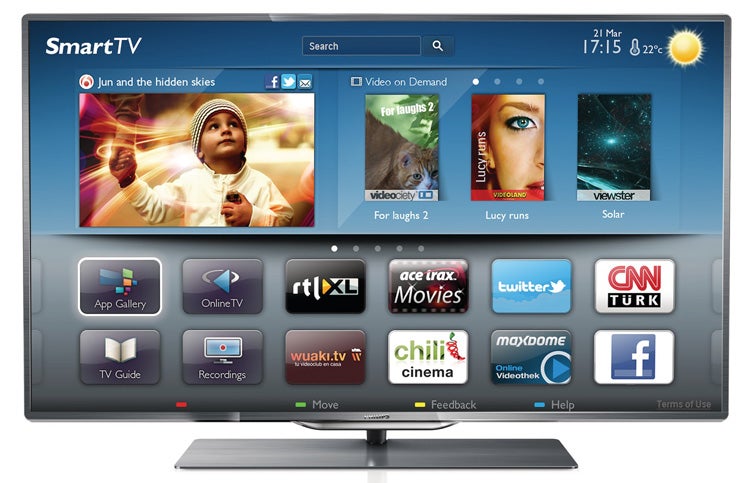
Verdict
Pros
- Sensational 2D picture quality
- Excellent backlight control
- Good remote control design
Cons
- Not quite as cheap as we'd like
- Requires care with its picture settings
- Crosstalk with 3D
Key Specifications
- Review Price: £1700.00
- 46in LCD TV with edge LED lighting
- active 3D playback
- Smart TV online functionality
- Perfect Pixel HD processing
- Multimedia playback via USB or LAN/wi-fi
Introduction
Ladies and gentlemen, Philips is back in the building. After what feels like years in the TV wilderness, the Dutch brand used this year’s IFA show in Berlin to formally announce its TV re-emergence, through a new TP Vision joint venture with Chinese manufacturer TPV technology. And now it’s got a whole range of honest-to-goodness products emerging to back up its bullish IFA words – kicking off with the model currently sat on our test benches: the Philips 46PFL8007.
Given that an element of the TP Vision venture is to make the brand’s TVs more competitive, it’s perhaps a little surprising to find the Philips 46PFL8007 sporting a current SRP of £1,700 – a not insubstantial sum for a 46-inch TV. You can, after all, get the superlative Sony KDL-46HX853 for £450 less.
Philips 46PFL8007 Design
Still, the Philips 46PFL8007 does sit very close to the top of Philips’ new TV range, a high position backed up by its exceptionally slim design, high-powered feature count and, as we’ll see, some pretty special picture quality. It’s also worth pointing out that it actually comes in cheaper than the SRP of the Samsung UE46ES8000.
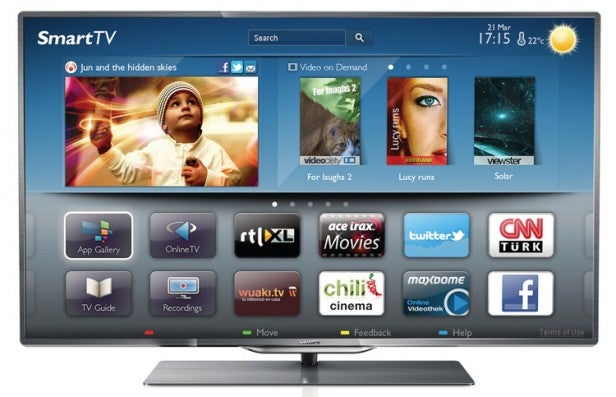
The Philips 46PFL8007’s design really is a beaut. In keeping with the latest fashions, the frame around the screen is barely a centimetre wide – and what little of it there is boasts a very fetching deep grey metallic finish. It’s distinguished too by Philips’ Ambilight system, where LEDs mounted on the TV’s rear emit coloured light you can set to harmonise with the colour content of the image being shown.
As always when you describe Ambilight on paper, it sounds gimmicky. But seeing is believing, and once you’ve lived with Ambilight for a while – provided you set it to one of its relatively subtle, gentle settings – you really miss its simultaneously engaging and soothing impact when it’s gone.
Even the Philips 46PFL8007’s stand warrants more attention than most. For as well as looking cute with its metallic top plate, it also contains the TV’s speakers. Experience suggests this can prove a very effective way of getting more audio oomph out of super-slim TVs, though in this case it does complicate setup, as it means you also need to use the stand as a wall mount if you go that route.
Philips has sensibly arranged all of the 46PFL8007 46-inch TV’s connections so that they can be accessed from the unit’s sides, and they’re startlingly prodigious, too. Particularly eye-catching is the provision of five HDMIs, finally getting us past the four limit we seem to have been stuck at for so long.
Philips 46PFL8007 Specs
Philips is one of the most on-the-ball AV brands around when it comes to handling multimedia sources, so it’s not surprising to find the Philips 46PFL8007 carrying three USBs as well as integrated Wi-Fi for accessing stuff stored on a networked DLNA PC. Formats supported include AVI, MKV, H264/MPEG-4 AVC, MPEG-1, MPEG-2, MPEG-4, WMV9/VC1, AAC, MP3, WMA, and JPEG.
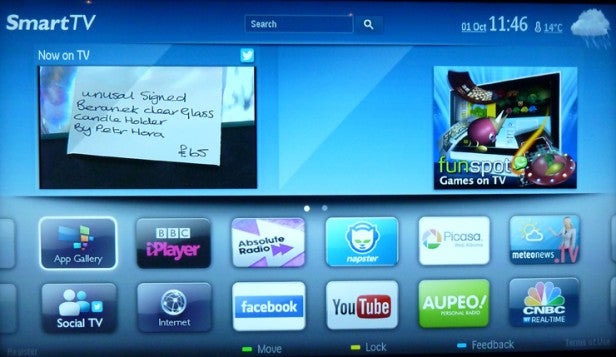
Unfortunately, the Philips website link to the Mac version of Philips’ Media Manager software wasn’t working during our tests, but hopefully this issue will be sorted soon.
The Wi-Fi (or LAN if you prefer the hardwired approach) also provides access to Philips’ latest Smart TV online platform. Having been shown a quite persuasive presentation on this at IFA 2012, we had high hopes for it. But actually it’s a bit disappointing – for now, at least.
The only notable content comprises the BBC iPlayer, Facebook, YouTube, Funspot, Viewster, Euronews, CNBC Real Time, Napster, iConcerts, Picasa, Absolute Radio, Aupeo, Films and Stars, TomTom HD Traffic, and Ted Talks.
We were quite surprised to also find a couple of ‘adult’ video services on there, but modesty prevents us from going into any more detail on these.
There are one or two innovations to be found in Philips’ online offering. For instance, the set’s Twitter app can automatically use metadata sent with the TV programme you’re watching to track down any ‘#’ threads associated with it. It’s also great to find a cute ‘clip-on’ Webcam included with the TV, enabling instant use of Skype.
Philips 46PFL8007 Features
In content terms, Philips reckons BlinkBox will be added to its Smart TV platform this month, with another movie rental service incoming for November. However, these promises do little to alleviate the over-riding impression that Philips is lagging behind the online services of its big-brand rivals.
The menus for the new Philips Smart TV system are reasonably easy on the eye. However, we were rather concerned by how much screen real estate is taken up by a single ‘highlighted/promoted’ service, and can’t help but think that the two rows of service icons along the bottom will quickly start to feel inadequate if Philips ever seriously ramps up its online offering. (Though you can manually choose which icons appear on the home screen, so your favourites are always readily accessible.)
Easily the best thing about Philips’ new Smart TV engine is the nifty new remote control that ships with the Philips 46PFL8007. This remote’s ‘killer app’ is a full QWERTY keyboard on its rear that proves surprisingly usable thanks to the way you can type on it using your thumbs while holding the remote sideways in both hands.
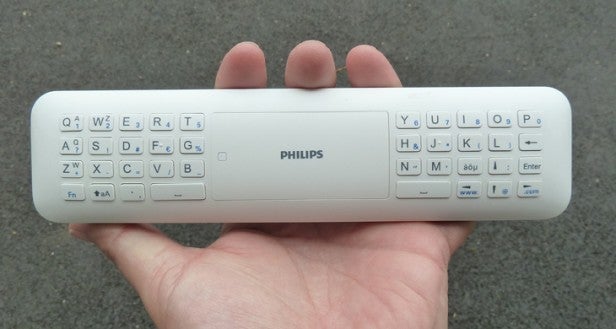
You don’t have to worry about inadvertently pressing buttons on the opposite side of the remote to the one you’re using either, as sensors inside know which side you’ve got facing up, so the remote can deactivate the buttons on the unused side.
As we’ve come to expect from Philips over the years, the 46PFL8007’s relatively high-end status finds it rocking some serious picture tech. At its heart is an edge LED engine with micro dimming, delivering a claimed contrast ratio of 500,000:1. It also employs a native 200Hz panel aided and abetted by Philips’ latest top-end image processing system, the Perfect Pixel HD Engine. Among this engine’s many talents are the ability to render a remarkable 2.250 trillion colours, and the facility through a blend of frame interpolation processing and backlight scanning to deliver the equivalent of 800Hz sampling when handling motion.
Next up on the Philips 46PFL8007’s feature list is the inevitable 3D support. This is of the active variety (you’ll need one of Philips’ upcoming PFL6007 models if you prefer passive), with two pairs of glasses handily included free of charge. You can also use the provided glasses and 3D system to deliver ‘Dual Play’, where two different gamers can enjoy full-screen 2D gaming simultaneously.
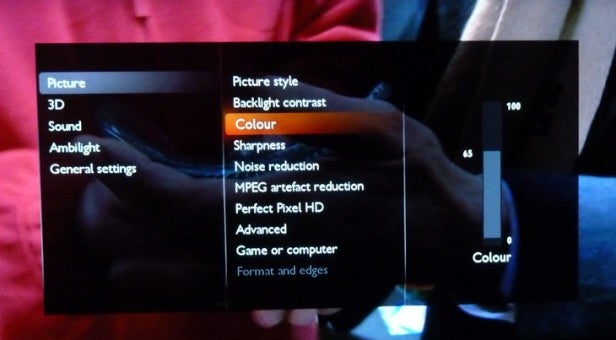
Some video purists have sought in the past to criticise Philips TVs for the amount of image processing they use. So in a sensible move to silence such critics, Philips has sought and obtained the endorsement of the independent Imaging Science Foundation (ISF), meaning that, a) you can call in an ISF engineer to professionally calibrate your Philips 46PFL8007 and, b) the TV has enough colour/gamma/white balance adjustments to satisfy ISF calibration requirements. Philips even provides a static warm white ISF Ambilight preset.
Other key settings that we strongly recommend you familiarise yourself with are different strengths for the TV’s Perfect Natural Motion processing, dynamic backlight and contrast settings, and various noise reduction systems. Some of these features can damage pictures more than they improve them if not used cautiously, but all warrant experimentation with different source types.
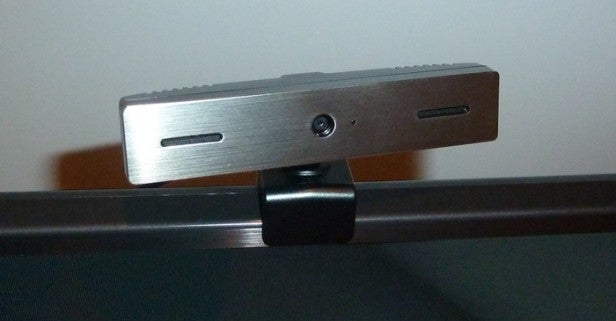
The good news is that once your period of experimentation is over, you should find yourself staring agog at genuine contenders for the best LCD pictures to date.
The single most critical key to their success is their superb handling of dark scenes. Far too many edge LED LCD TVs this year have struggled with such scenes, either failing to produce a convincing black colour or else suffering with distracting backlight inconsistencies and/or ugly light ‘blocking’ around bright objects. But the Philips 46PFL8007 suffers with precisely none of these problems, instead producing remarkably inky blacks within the same frame as exceptionally punchy, bright whites and colours. And those inky blacks look perfectly consistent, with no nasty accidental light leaks or ‘chunks’ to spoil the show.
Philips 46PFL8007 Picture Quality
The lack of greyness hanging over the Philips 46PFL8007’s dark scenes also helps dark colours look richer and more natural then they tend to with LCD TVs. Plus, just as importantly, the delivery of a really deep black colour helps dark scenes achieve a similar sense of depth to bright scenes, making the experience of watching a film feel much more consistent.
Shifting our focus to bright, colourful content, the Philips 46PFL8007 is just as impressive. The set’s colour range is nothing short of spectacular, yet never does this extremity of colour expression come at the expense of subtlety, as every imaginable shade, hue and blend between is effortlessly rendered. Whites are pure, bright and clean, meanwhile, yet there’s no sense of detail clipping in even the brightest image areas.
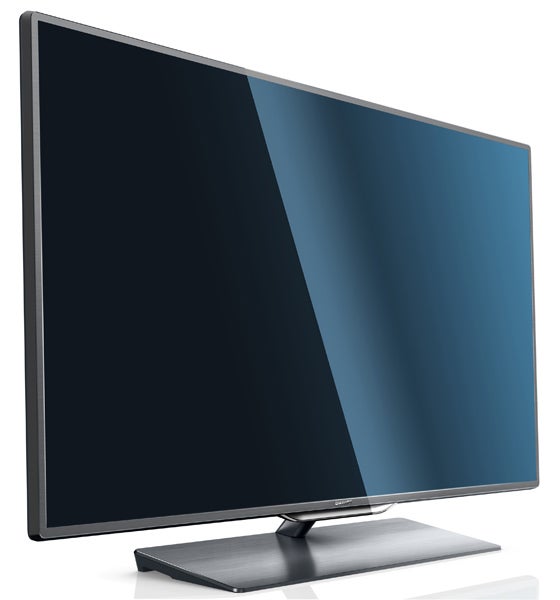
Then there’s the image’s sharpness. HD images look almost forensically stuffed with fine detail information, while edges look jaggie-free and as crisp as the edges of the TV’s slinky bezel. Motion scarcely diminishes the image’s sharpness either, even if you opt not to bother with the provided Perfect Natural Motion circuitry (which can give films an unwanted ‘video’ look).
Put the Philips 46PFL8007’s sublime colour, contrast and sharpness efforts together, et voila: you’ve got HD pictures as good as any we’ve seen from an LED TV, even going toe to toe with the efforts of Sony’s terrific HX853 models.
The Philips 46PFL8007’s potent image processing additionally helps it deliver a strong standard definition performance, as pictures are upscaled with plenty of sharpness being added without noise being exaggerated. Just make sure you don’t use the Natural Motion system with standard def, though, as (with low-quality digital sources in particular) it tends to cause some quite distracting lagging and twitching noise.
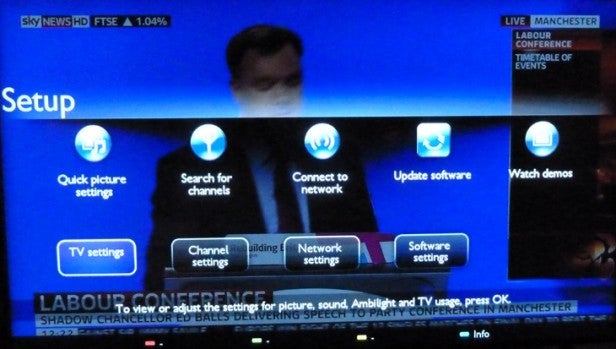
Next up is 3D. And there’s plenty to celebrate here too, such as a continuation of the rich detail levels noted with 2D HD; impressively vibrant colours and bold brightness levels despite the dulling impact of the active shutter glasses; and a really rich sense of depth enhanced by the set’s stunning contrast range.
There are a couple of 3D problems too, though. First, although Philips has clearly reduced crosstalk from the levels noted on its previous TV generations, there’s is still evidence of it over sharply contrasted background objects. This can also make some backgrounds look slightly out of focus.
The other concern is motion. For without using the Philips 46PFL8007’s Perfect Natural Motion system there’s some minor judder over moving objects. Yet introducing Natural Motion – even at its lowest power level – causes some surprisingly strong unwanted processing side effects, such as twitching edges and a shimmering, laggy sensation during camera pans.
Looking for other more general problems with the Philips 46PFL8007’s pictures, some of the set’s contrast tools/settings can be over-aggressive, causing some distracting brightness shifts as they try to adjust luminance levels to suit the image content.
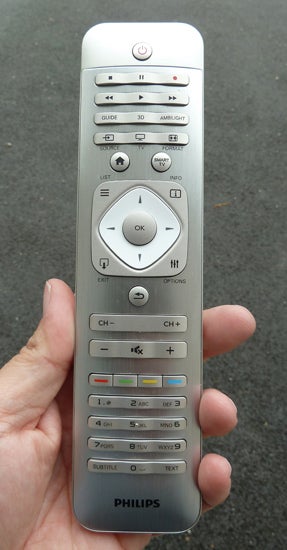
The very darkest segments of pictures can lack a little shadow detail subtlety compared with Sony’s HX853 models too; input lag measured a somewhat high 64ms even in the TV’s Game mode; and we must stress again how important it is that you take the time to explore the extensive set of picture processing adjustments the TV puts at your disposal – a fact which makes the TV more complex to use than most.
Philips 46PFL8007 Sound Quality
It really wouldn’t be fair to finish the review of the excellent Philips 46PFL8007 on a downer, though. So we’re happy to report that Philips’ new TV is an unusually strong audio performer. The speakers built into its stand/mount don’t look big enough to produce much audio wallop, but the TV immediately proves able to accompany its mostly stellar pictures with a more rounded, bass-laden and open sound than you get from any other ultra-slim TV we can think of.
Philips 46PFL8007 Verdict
A currently underwhelming online service together with a bit of crosstalk with 3D and some slightly high input lag fetch the Philips 46PFL8007 up short of perfection.
However, its 2D picture quality is nothing short of outstanding. It also sounds great, is extremely multimedia savvy, and delivers one of the best remote controls we’ve seen. All of which ensures that Philips’ return to the TV world can be considered little short of a triumph.
How we test televisions
We test every TV we review thoroughly over an extended period of time. We use industry standard tests to compare features properly. We’ll always tell you what we find. We never, ever, accept money to review a product.
Trusted Score
Score in detail
-
Features 9
-
3D Quality 8
-
Value 8
-
Design 10
-
2D Quality 10
-
Sound Quality 9
Features
| Size (Inch) | 46in |
| Display Type | LED |
| Max. Resolution | 1920 x 1080 |
| Full HD 1080p | Yes |
| Digital Tuner | Yes |
| Freeview HD | Yes |
| Freesat HD | No |
| 3D Ready | Yes |
| Contrast Ratio | 500,000:1 |
| Refresh Rate (Hertz) | 800Hz |
Connectivity
| HDMI | 5 |
| Component | 1 |
| Composite | 1 |
| Scart | 1 (via supplied adaptor) |
| Digital Audio Out | 1 (optical) |
| Headphone | 1 |
| Ethernet | 1 |
| WiFi | Yes (built-in) |
Physical Specifications
| Height (Millimeter) | 599mm |
| Width (Millimeter) | 1042mm |
| Depth (Millimeter) | 29.8mm |
| Weight (Gram) | 14000g |

